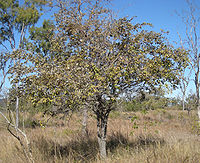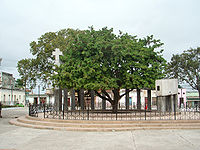- Underutilized crop
-
Neglected and underutilized crops are domesticated plant species that have been used for centuries or even millennia for their food, fibre, fodder, oil or medicinal properties, but have been reduced in importance over time owing to particular supply and use constraints. These can inter alia include poor shelf life, un-recognized nutritional value, poor consumer awareness and reputational problems ("poor people's food"). As the demand for plant and crop attributes changes (re-appraisal or discovery of nutritional traits, culinary value, adaptation to climate change, etc.), neglected crops can overcome the constraints to the wider production and use. As a matter of fact, many formerly neglected crops are now globally significant crops (oilpalm, soybean, kiwi fruit). Although the options for scaling-up neglected crops for large-scale agriculture appear to be increasingly exhausted, many species have the potential to contribute to food security, nutrition, dietary and culinary diversification, health and income generation. They also provide environmental services.[1] It is impossible to define what would constitute "proper" or "correct" levels of utilization, however, it is evident that many neglected species are under-utilized relative to their nutritional value and productivity.
Contents
Overview
Just three crops - maize, wheat and rice - account for about 40% of the world's consumption of calories and protein. 95% of the world's food needs are provided for by just 30 species of plants. In stark contrast, at least 12,650 species names have been compiled as edible (Kunkel 1984). Neglected and underutilized plants are those that could be - and, in many cases, historically have been - used for food and other uses on a larger scale. Such crop species have also been described as "minor", "orphan", "promising" and "little-used". They continue to play an important role in the subsistence and economy of poor people throughout the developing world, particularly in the agrobiodiversity-rich tropics. Despite their potential for dietary diversification and the provision of micro-nutrients such as vitamins and minerals, they continue to attract little research and development attention.
Alongside their commercial potential, many of the underutilized crops also provide important environmental services, as they are adapted to marginal soil and climate conditions.

.
It is difficult to precisely define which attributes makes a crop "underutilized", but often they display the following features:
- Linkage with the cultural heritage of their places of origin
- Local and traditional crops whose distribution, biology, cultivation and uses are poorly documented
- Adaptation to specific agro-ecological niches and marginal land
- Weak or no formal seed supply systems
- Traditional uses in localized areas
- Produced in traditional production systems with little or no external inputs
- Receive little attention from research, extension services, policy and decision makers, donors, technology providers and consumers
- May be highly nutritious and/or have medicinal properties or other multiple uses.
See also
- Food security
- Heirloom plant
- List of useful plants
- Slow Food
- Subsistence farming
References
- ^ International Centre for Underutilised Crops
Kunkel G. 1984. Plants for Human Consumption. Koeltz Scientific Books, Koenigstein, Germany.
External links
- Crops for the Future
- The Global Facilitation Unit for Underutilized Species
- Consultation on the Role of Biodiversity in Achieving the UN Millennium Development Goal
- NUS Database Asia
- US Plant Database Search Page
- Spices - by Gernot Katzer
- Photos of Asian Plants - Hiroshima University
- NewCROP the New Crop Resource Online Program
Categories:- Sustainability
- Crops
Wikimedia Foundation. 2010.


